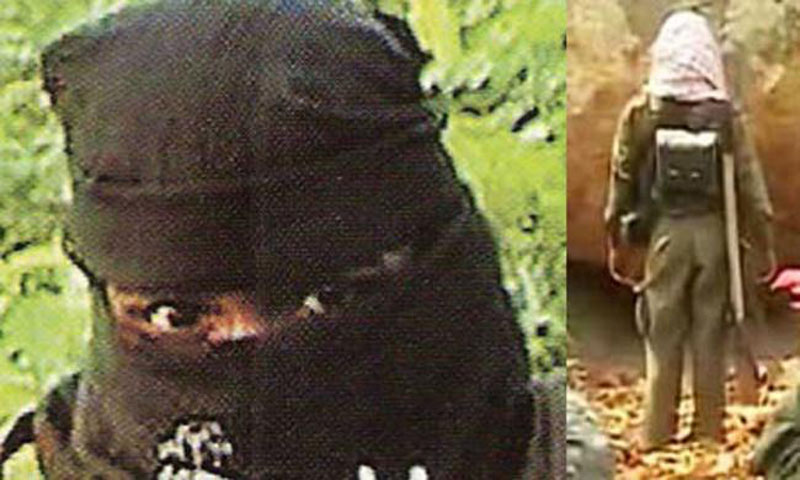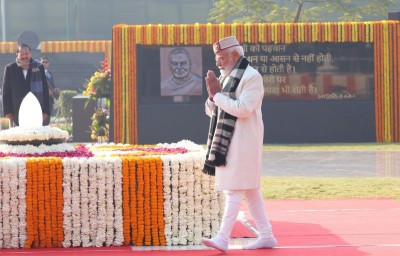 Odisha
Odisha
Odisha: Marginal Escalation
Research Associate, Institute for Conflict Management
On February 2, 2023, a huge Communist Party of India-Maoist (CPI-Maoist) supply dump was recovered during a combing operation by Security Forces (SFs) in Bhuruti Forest under Narla Police limits in the Kalahandi District of Odisha.
The seized items include one Bharmar (country made muzzle loading gun), 11 electric detonators, gun powder, electric wire, batteries, Mosquito nets, water bottles, one axe, torchlights, items of clothing, medicines, a Maoist banner and Naxal [Left Wing Extremism, LWE] literature.
On January 26, 2023, the Odisha Police discovered an ammunition dump suspected to have been used by the CPI-Maoist for illegal manufacturing and repair of weapons in the Jajbhata area (Tulsi Pahad) between Kirmiti and Katuapadar villages, under Mathili Police limits in Malkangiri District. The dumped material included Improvised Explosive Devices (IEDs).
Thus, two incidents of arms recovery have been recorded in Odisha in 2023, thus far (data till February 12). According to partial data collated by the South Asia Terrorism Portal (SATP), 27 incidents of arms recovery were recorded in 2022 in Odisha, in addition to 25 such recoveries in 2021. The total number of such recoveries, since March 6, 2000, when SATP started documenting LWE-related incidents across the country, was 589.
Meanwhile, on January 24, 2023, two CPI-Maoist cadres, identified as Poje Mandavi aka Anita (25), and Samudra Bagh (32), both members of the CPI-Maoist’s Mainpur Nuapada Division, were arrested by Police from the Hatigaon Forest area under the Raighar Police Station in Nabarangpur District. Anita had joined the Maoist fold in 2010 and was working as a party member of the Bodchatia Local Organisation Squad (LOS) before joining the Mainpur-Nuapada Division. She has been active since 2013, and was promoted as an ‘area committee member (ACM)’ in 2020.
In a separate incident on same day, January 24, 2023, the National Investigation Agency (NIA), with the help of the Odisha Police, arrested wanted CPI-Maoist cadre, Ranju Khillo aka Chanti aka Bishant aka Bingshanta (40), from the Swabhiman Anchal (the erstwhile cut-off region) in Malkangiri District. Chanti was suspected to have been involved in Border Security Force (BSF) Commandant J.R. Kashwan killing in 2012. NIA had registered a case [No-RC-02/2012/NIA/DLI arising out of Chitrakonda PS case No-07/2012, dated February 10, 2012], in connection with the Maoist attack on the BSF, in which at least four officers were killed.
Three LWE cadre have been arrested in 2023, thus far (data till February 12). SFs arrested a total of five LWE elements in 2022, in addition to four in 2021. The total of such arrests stands at 1,586, since March 6, 2000.
On January 26, 2023, three CPI-Maoist cadres – Manoj aka Mati Madhi (24), Pandu Kabasi (27) and Aite Karttami (21) – surrendered before the Police in Swabhiman Anchal in Malkangiri District. The three, residents of Daldali village under the Mathili Police Station of Malkangiri District, each carrying a cash reward of INR 100,000 on their heads, were active members of the CPI-Maoist’s Dandakaranya Special Zonal Committee (DKSZC).
Three LWE cadres have surrendered in 2023 (data till February 12). A total of 2,498 LWE elements surrendered in 2022, in addition to 21 in 2021. The total of such surrenders stands at 7,288, since March 6, 2000.
Odisha recorded 12 incidents of LWE-linked killings, resulting in 17 fatalities (seven civilians, three SF personal, and seven LWEs) in 2022; as against nine incidents of LWE-linked killings, resulting in 11 fatalities (three civilians, and eight LWEs) in 2021, an increase of 54.54 per cent in overall fatalities. Overall fatalities recorded in the State have followed a cyclical pattern since 2010, when fatalities were last recorded in the triple digits, at 112. There was a marginal spike in 2022, from 11 in 2021 to 17 in 2022, repeating the pattern observed in 2015, when fatalities rose to 47, from 42 in 2014; and again, to 23 in 2020, from 19 in 2019
Civilian fatalities have also recorded an irregular pattern, more than doubling from three in 2021 to seven in 2022. As in case of overall fatalities, though no definitive trend is established, spikes in this category have been recorded twice since 2010: in 2014 at 30 from 22 in 2013; and in 2016 at 27 from 21 in 2015. 2010, was the worst year, with 62 fatalities in this category, while 2004 was the best, when no such fatality was recorded.
Civilians have been the worst hit category in Odisha, with 372 fatalities since March 6, 2000. The SF category registered 227 fatalities, while there were 323 fatalities in the LWE category.
Troublingly, SFs suffered three fatalities in 2022, as against no fatality recorded in 2021. There were two fatalities in this category in 2020. In 2008, 77 SF personnel were killed, the maximum in a year. Significantly, the SFs did not suffer any fatality in 2000.
Fatalities among LWE elements dropped to seven in 2022, as against eight in 2021. There were 17 fatalities in this category in 2020. In 2016, 42 LWE elements were killed, the maximum in a year.
The SF:LWE kill ratio was 1:2.33 in 2022. In 2021, SFs did not suffer any casualty, and they killed eight LWE elements. The overall kill ratio since 2000, stands at 1:1.42. Significantly, the ratio favoured SFs in 13 years [2005 (1:3); 2006 (1:3.25); 2007 (1:4); 2010 (1:1.66); 2011 (1:5); 2013 (1:4.14); 2014 (1:11); 2015 (1:7.66); 2016 (1:14); 2017 (1:1.22); 2018 (1:18); 2019 (1:8); and 2020 (1:8.5). The kill ratio went in favour of the LWEs in six years, 2001 (2.66:1); 2002 (10:1); 2003 (5.25:1); 2008 (2.33:1); 2009 (2.06:1); and 2012 (1.07:1). In 2004, the Maoists did not suffer any casualty, and they killed five SF personnel.
Other parameters of violence also registered a small spike in 2022, even though the influence and impact of the rebels remained more or less at the same level in the State. The Maoists were involved in five incidents of arson in 2022, as against one such incident in 2021. One major incident (resulting in three or more fatalities), in which three SF personnel were killed, was recorded in 2022, and one in 2021, when three LWE elements were neutralised. Similarly, at least one incident of abduction (in which one civilian was abducted and killed as a suspected ‘Police informer’) by the Maoists was reported in 2022, and one such incident in 2021 as well (in which three persons were abducted of which two persons were released after ‘warnings’ while one person’s whereabouts remain untraced). Further, one bandh (total shut down) call was given by the rebels in 2022, as in 2021. A total of 53 LWE-related incidents were recorded in 2022, and the same number of such incidents was recorded in 2021.
Meanwhile, an analysis of overground and underground Maoist activities in Odisha suggests a status quo in the ‘moderately affected’ category, while there was a decline of one District in the ‘marginally affected’ category. According to SATP, in 2022, Maoist activities were reported from nine Districts of Odisha’s 30 Districts. Six Districts (Bolangir, Kandhamal, Nuapada, Kalahandi, Koraput, and Malkangiri), fell in the ‘moderately affected’ category, while the remaining three Districts (Bargarh, Nabarangpur, and Rayagada) were ‘marginally affected’. By comparison, in 2021, Maoist activities were reported from 10 Districts. Six Districts (Bargarh, Bolangir, Kalahandi, Kandhamal, Malkangiri, and Rayagada) were ‘moderately affected’; while the remaining four (Koraput, Nabarangpur, Nuapada, and Sundargarh) were ‘marginally affected’.
Further, according to the latest available Government data, three of Odisha’s Districts – Kalahandi, Kandhamal and Malkangiri, are among the 25 ‘Most Affected Districts’ from eight States across India, identified by the Union Ministry of Home Affairs (UMHA). Moreover, Koraput is among eight Districts from six States, classified as ‘Districts of Concern’. Further, 10 Districts – Bargarh, Bolangir, Kalahandi, Kandhamal, Koraput, Malkangiri, Nabarangpur, Nuapada, Rayagada, and Sundargarh – are covered under the ‘Security Related Expenditure (SRE)’ scheme, which underwrites focused operations against the Naxalites, among 70 LWE-affected Districts in 10 States across the country.
Moreover, according to a November 5, 2022, report, considering Odisha's vulnerability to Maoist activities in neighbouring Chhattisgarh, which is considered to be the last Maoist stronghold, a Joint Task Force comprising Central Reserve Police Force (CRPF), District Voluntary Force (DVF) and the Special Operation Group (SOG), has been proposed to be formed in Odisha's Nuapada District, to strengthen anti-Maoist operations in areas along the Chhattisgarh border, and to prevent movement of LWEs between the two States. Odisha Director General of Police (DGP) Sunil Bansal inaugurated a District Intelligence and Operation Centre (DI & OC) in Nuapada on November 4, 2022, and disclosed,
Recently, I had discussion with the Chhattisgarh DGP on setting up more camps and reinforcement of forces in the sensitive areas. It has been decided that a joint task force will be formed in the district to strengthen operations against LWE.
DGP, Bansal also directed his forces to intensify anti-Maoists operations and to set up more camps, in order to plug the security gaps in the region.
A residual Maoist threat persists in the State. A January 22, 2023, report, revealed that three top-ranked Naxalites wanted by the NIA were reportedly active in the Andhra Odisha Border Special Zonal Committee (AOBSZC) region. The NIA released posters of Gajarla Ravi aka Uday, a native of Warangal District in Telangana; Jalumuri Srinu, who hails from the East Godavari District of Andhra Pradesh, and Metturu Joga Rao aka Tech Shankar, a resident of the Srikakulam District of Andhra Pradesh. The Kolkata branch of NIA has announced an INR one million cash reward for information on Uday; and INR 500,000 each for Srinu and Tech Shankar.
On November 25, 2022, a Maoist banner that read ‘Bharatiya Communist Party (Maobadi)’ and “the ministers of Odisha government who have been threatening the voters ahead of the Padampur by-election will be given a strong reply. The voters are requested to vote for a good candidate – Chhattisgarh Odisha Mao Sangathan”.
Further, on November 3, 2022, through posters and banners found near Pukali and Dudhari junctions within Pottangi and Semliguda Police Station limits, respectively, in Koraput District, the Odisha committee of the CPI-Maoist accused six persons of working as ‘brokers’ for the Hindalco and Maitri mining companies, to exploit Bauxite reserves in the area. The letters warned that if such activities were not stopped immediately, the accused would be ‘punished’ by the Maoists’ ‘Praja court’ (people’s/ Kangaroo Court held by the rebels).
Despite an enduring Maoist challenge over the decades, the Odisha Police continues to face deficits in terms of capacities to fight the Maoist threat as well as with general duties of policing in the State. According to the latest Bureau of Police Research and Development (BPR&D) data, as on January 1, 2021, Odisha had 141.29 Police personnel per 100,000 population, significantly below the inadequate national average of 152.51. The Police/Area Ratio (number of policemen per 100 square kilometers) is just 41.33, as against the national average of 62.96. Both the State and national averages on the Police/Area ratio are below the sanctioned strength, at 48.36 and 80.07, respectively. The sanctioned strength for the States’ Police is 75,300, but 64,359 personnel were in position, a deficit of 14.52 per cent. In addition, the sanctioned strength of the apex Indian Police Service (IPS) Officers in the State is 195, but just 124 officers were in position, a deficit of 36.41 per cent, which considerably weakens the executive supervision of the Force. Moreover, as against a sanctioned strength of 627 Police Stations, there were 626 Police Stations in the State and, inexcusably, at least four of these had no vehicles and three had no telephones.
Maoist losses following the 2016 twin encounters in the Bejingi forest area, between Ramgarh and Panasput, in the Malkangiri District, which wiped out a critical safe haven, are evident in the State. Yet, residual elements of the ‘movement’ in the State cannot be ignored. Continuous and sustained SF operations are a necessity to contain Maoist efforts, and to establish an enduring peace in the State.
Support Our Journalism
We cannot do without you.. your contribution supports unbiased journalism
IBNS is not driven by any ism- not wokeism, not racism, not skewed secularism, not hyper right-wing or left liberal ideals, nor by any hardline religious beliefs or hyper nationalism. We want to serve you good old objective news, as they are. We do not judge or preach. We let people decide for themselves. We only try to present factual and well-sourced news.







